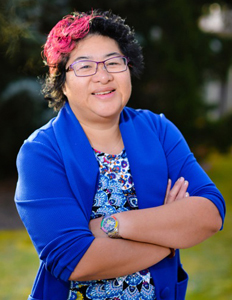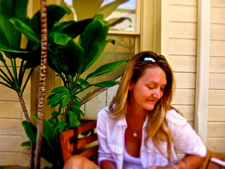The Braided Essay: Serena Shipp in Conversation with Dale Lee Kwong

Malahat volunteer Serena Shipp talks with Dale Lee Kwong about the braided essay, Chinese-Canadian history, and the national anthem in her genre-bending nonfiction piece, "Oh, Canada."
Dale Lee Kwong's piece is published in Issue #193, Elusive Boundaries: Mapping Creative Nonfiction in Canada, a special themed issue dedicated entirely to works of CNF, edited by Lynne Van Luven.
First off, well done. Your approach to writing “Oh, Canada” was delicate and bold all at once. By breaking apart and analyzing the lyrics of the Canadian national anthem, you’ve entered into a portal where you are safe to explore the sticky, bungled matters of Canadian history from a new vantage point. I appreciate your dance between strictly prose and poetic sections. Is creative nonfiction your genre of choice, or do you write in other genres as well? Which is your preferred genre?
I write poetry, monologues and plays, essays and memoir pieces. Creative nonfiction seems to best suit my personality; I am a forthright and honest person who doesn’t mince words. I love that rules can be broken. Additionally, I respect and expect more of CNF readers. I am more willing to let readers connect the dots in CNF. In other genres I am less sure of my use of metaphor and simile, and therefore apt to insert flashing neon signs in the writing. Then I’ll ask the reader if they caught the clever comparison or subtle wording, and it is all for naught.
Which came first? The poetic subsections, or the “O Canada” inspired prose structure of the essay?
The poems came first. In fact, some were written more than 5 years ago when I took a poetry class with Tom Wayman at the University of Calgary. I would have liked to include more poetry, but was fortunate to have some on hand.
You’re confident and clear in your prose writing, but you soar at another level when you are writing in the more free-form poetic style. The subsection you titled “Railroaded” was gorgeously experimental and added so much to the essay. It acted as a breath, where I (as the reader) was allowed to pause, interpret, and digest all the information. What was your inspiration for these pocket-sized poetic asides? (For the sake of these questions, I’ll continue to refer to the two as prose and poetry, even if they might not be so quickly divided.)
The prose writing was initially more like an info dump, so I needed the poetry for all the reasons you mention and more. As in all my writing, the inspiration comes from my own experiences as a third-generation Chinese-Canadian, an LGBTQ woman who was adopted at birth, and raised in a Chinese family.
Have you written essays in this structure before? Sliding between prose and poetry? Following the lyrics to an anthem/song/other piece of writing as the overarching structure for your own essay? The ability to borrow aspects of other genres and apply them to the essay form is truly one of my favourite aspects of creative nonfiction.
I have not written an essay that was a specific response to a song or anthem, but presenting more than one point-of-view or thought is a style of composition I often employ. Early in my writing career, I studied with Fred Wah at the Banff Centre. One exercise we did deliberately mashed-up two unrelated pieces of text. I learned that tensions and connections could be produced or implied simply by putting two things together. The writer can create a relationship where one might not have previously existed. Craft can heighten the effect. I have used this technique in my poetry and some essays. It allows the writer to accomplish more with less. It feels more active to me and invites readers to engage with their own response. Even this document with your questions and my interjected answers has a push-pull, back and forth to it. No?
The idea of braiding more than one idea into an essay is not new. I am greatly inspired by the essay “On Separation” in Susan Olding’s collection, Pathologies: A Life in Essays. She deftly braids three threads together: how to separate eggs to make almond cake, her sister in-law’s diagnosis and death from breast cancer, and definitions of the word “separation”.
I wanted to include a third thread—the rules for playing mahjong—in “Oh, Canada”, but I ran out of time to weave it in. Perhaps in a future version?
How much did your chosen structure (analyzing and reflecting on the lyrics of the national anthem) guide the content of the essay? Do you feel it opened up discussion in varying topics, or do you feel it limited you to using only those O Canada heading topics?
It’s been my intention to write something about my bittersweet feelings toward Canada Day for a few years. Ironically, I had left it to the last day to write the essay, and the deadline was midnight on Canada Day. I realized I wouldn’t be able to participate in any of the celebrations, and was surprised I few regrets about it. I had participated in the initial discussions of a Canada Day event at my former place of employment. As I watched new Canadians singing O Canada at a Citizenship ceremony on television, I wondered if they knew Canada’s muddied history.
It’s only recently that I’ve become familiar with Chinese-Canadian history myself, so the experience of writing the piece both forced and allowed me to explore conflicting feelings more closely than I had dared before. I hoped my knowledge and emotions of the Chinese experience could shine light on other examples of discrimination and exclusion in Canada. I recall somewhere during the process I cried at the keyboard, and that’s when I knew the piece could really be used to recount unspeakable things and make an impact on others.
Once I chose to dissect the national anthem, each line functioned like a writing prompt. I wondered what other Canadians would have trouble singing the words. It became clear that the lyrics naturally exposed many cultures of Canadian society that have been disrespected. I didn’t feel I could speak for these other people; therefore, those sections are more of an information dump. I wish there was more personal response and less information in the piece, but my feelings were like an open wound and the essay was all I could muster at the time of writing. I would have liked to include homosexuals and Ukrainians detained in internment camps, but those subjects did not seem to naturally blend in.
Is there anything you would like your readers to know about this essay, or the experience of writing it?
I would challenge readers to really think about the lyrics next time they sing our national anthem. Who does the land really belong to? Why are only sons recognized? Is our history truly glorious and free? Do the lyrics really speak for all Canadians? What can we do as individuals to be more inclusive?
Where can I read some of your other works?
I have essays published in two anthologies by Touchwood Publications: Somebody’s Child: Stories about Adoption and A Family By Any Other Name: Exploring Queer Relationships.
Last year I participated in a really interesting project called Noir on Eighth. It is a collaborative serial novel that was rolled out (live!) over eight months and written by twelve prominent Calgary writers. It’s published by House of Blue Skies, and can be read online. I am very proud of (my) Chapter 8, which incorporated a lot of history from Calgary’s Chinatown.
I have poetry in The Calgary Project: A City Map in Verse and Visual (House of Blue Skies, 2014). That is a beautiful coffee-table book that includes many Calgary artists, photographers and writers. The first poem is by Mayor Nenshi. I have additional poetry published in Modern Morsels: Selections of Canadian Poetry and Short Fiction (McGraw-Hill Ryerson, 2012) and Canadian Literature (Issue 199, 2009).
I’ve also had one play production and several workshops. Mei-Mei’s Dream is about a Chinese adoptee who dreams that she and her kite fly back to China and meet a Chinese orphan. It was commissioned and produced with about 80 community performers; I have a three-hander version of this script that I sometimes perform in Calgary. Ai Yah! Sweet and Sour Secrets is a one-act comedy about a lesbian who is forced out of the closet to her traditional Chinese parents at Chinese New Year. It was commissioned and workshopped but not yet produced. It would be fun to adapt the plays into other genres.
Thank you so much for your time, and I look forward to reading more of your work in the future. Any closing thoughts?
I really want to thank Lynne van Luven for pushing the piece further, but especially for challenging me to write something when I saw her at last year’s CNFC conference in Victoria. CNFC is a wonderful organization for writers in many genres, and I hope many of you will join us at this year’s conference in Banff!
* * * * * * * *










